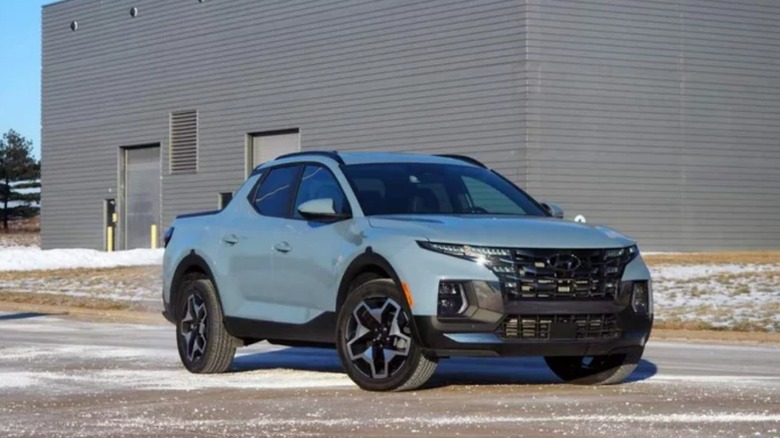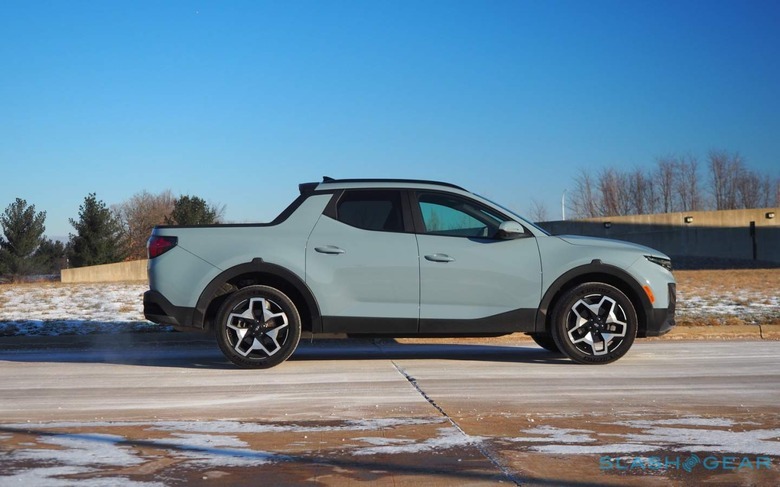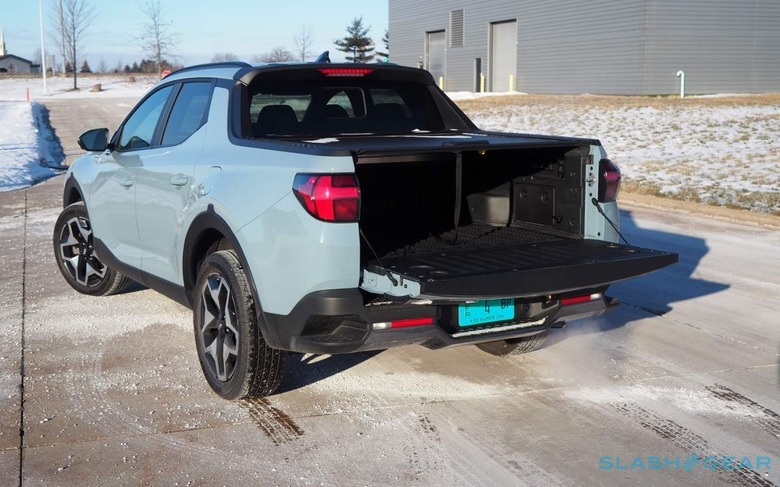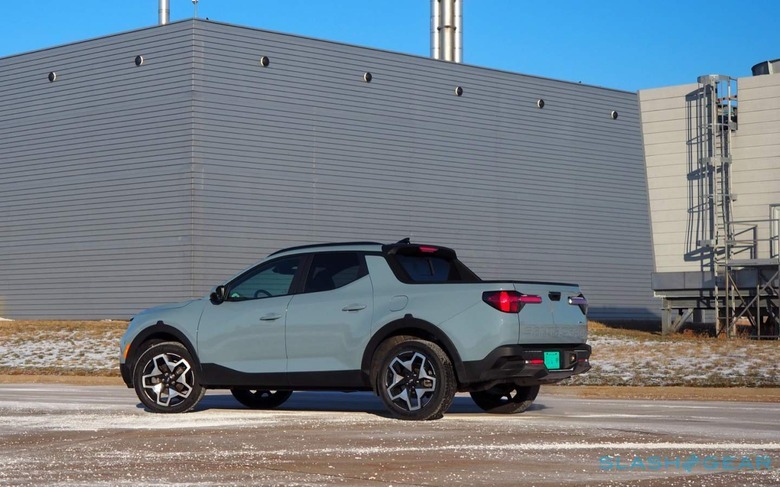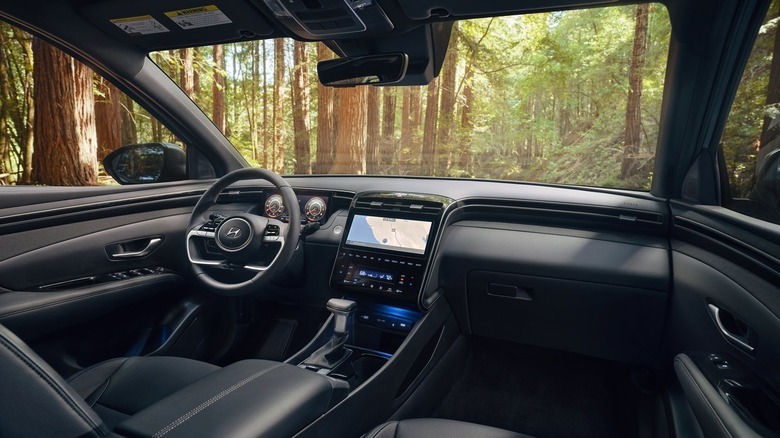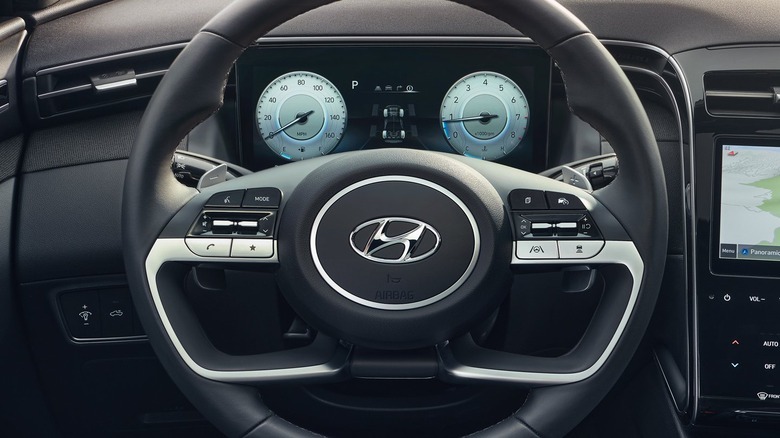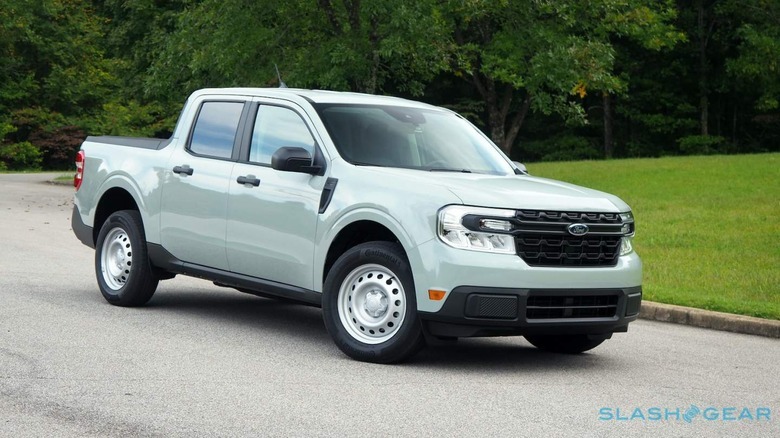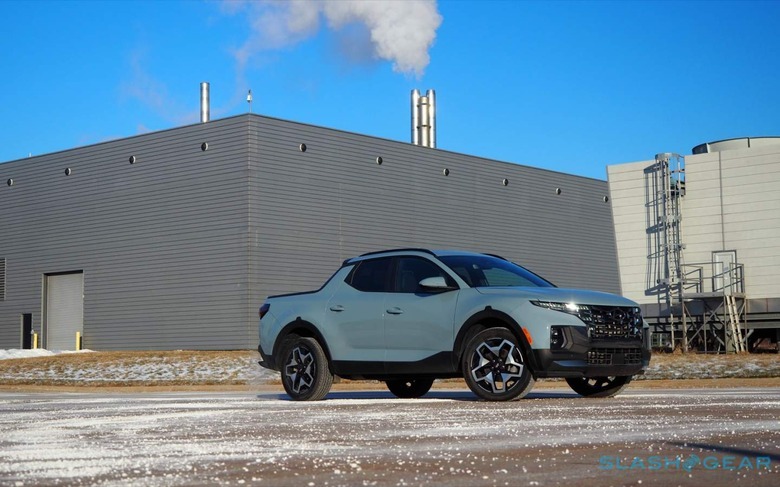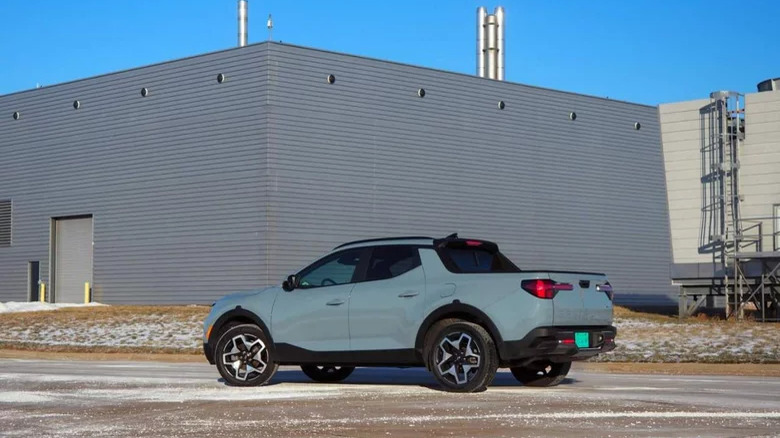2022 Hyundai Santa Cruz Review: Picking The Right Size Pickup
Parked next to an F-150 or a Silverado, the 2022 Hyundai Santa Cruz thoroughly bucks the trend in pickups over the past decade or so. At a time when it has become increasingly difficult to find a smaller truck, as they steadily grow in size as well as capabilities, Hyundai poses a different question. Just how much pickup do you really, truly need?
Hyundai's latest design language is leagues away from the dreary, forgettable models that seemed determined to earn an anonymous spot on an Avis courtyard. The grille is wide and bold, punctuated with the Santa Cruz's headlamps and daytime running lights. From the side, the sculpted fenders and curvaceous roofline and C-pillar combo leave the diminutive pickup looking more like a moon buggy than a terrestrial truck.
It's chunky, and endearing, and pleasingly practical too. At just shy of 200 inches long and 75 inches wide, it's about a foot and a half longer than the Tucson it's closely related to. Almost 4.5 foot of that length goes on the bed, which is 52.1 inches long and 53.9 inches wide. The wheel wells narrow that down to just under 43 inches.
In macho truck world, there's no shortage of shade thrown at the Santa Cruz. Despite that, it's hard to imagine the Hyundai's capabilities holding up for the vast majority of pickup owners. In front-wheel drive form it'll handle up to 1,753 pounds of payload, engine and trim depending; all-wheel drive lowers that to 1,609 pounds. For towing, you're looking at up to 3,500 pounds for the FWD, or 5,000 for the AWD.
Hyundai's bed is a practical one, too. The slide-out hard tonneau cover – standard on SEL Premium and Limited trims – locks into place for security, and there's a sizable cargo box underneath that's also lockable and has drainage holes for easy rinsing. Even getting up to the bed is more straightforward, with molded steps in the rear bumper, and there are plenty of tie-down loops along with the sliding rail anchors.
If you've ever tried to fit a mountain bike or easy chair into the back of an SUV, or for that matter attempted to brush out the luggage compartment after hauling a bunch of chopped wood, the idea of a more rugged – though not oversized – bed probably already makes sense to you. The downside is that more space for cargo there means less legroom in the second row, compared to the Tucson. Adults will fit, but it's definitely more snug for their legs; the upside is that lifting the bench reveals some handy extra storage bins.
Base models get a 2.5-liter 4-cylinder gas engine, with 191 horsepower and 181 lb-ft of torque. Front-wheel drive is standard, with an 8-speed torque converter automatic; all-wheel drive is a $1,500 option. The upgrade is a far punchier 2.5-liter turbo version, with 281 hp and 311 lb-ft. It has an 8-speed wet dual clutch with paddle-shifters, AWD, and the ability to lock the center diff for a 50/50 power split.
My inclination would be to skip Hyundai's adequate but not exactly exciting naturally-aspirated 4-pot, and go straight to the far more engaging turbo. It has more than enough power to keep up in the fast lane, and is pleasingly punchy day to day. Ride, too, is more SUV-like than most trucks, with plenty of composure even with the bed loaded up. Hyundai rates the base engine with FWD as good for 21 mpg in the city and 26 mpg on the highway, while the AWD Turbo should do 19 mpg in the city and 27 mpg on the highway. In my own, mixed driving in the latter I saw just short of 22 mpg.
Inside, the Tucson connection is obvious. Base trims get an 8-inch touchscreen with wireless Apple CarPlay and Android Auto; higher-spec models have a 10.3-inch screen, but wired phone connectivity. That's an oddity shared with other models in Hyundai's range. Below the display there's a glossy black panel of touch-sensitive buttons for HVAC, navigation, and – sadly – controlling the volume.
Skipping the $24,140 (plus $1,495 destination) SE base trim and going straight to $27,3409 SEL seems wise. That way, you get heated side mirrors with blind-spot warnings, an 8-way power driver's seat with front row heating, SiriusXM, and at least the option of the 10.25-inch digital driver's cluster. The latter is standard on the $35,830 SEL Premium and $39,870 Limited trims, as is LED bed lighting and a 115V power outlet, 20-inch wheels, a rear sliding glass window, leather steering wheel and transmission shifter, dual zone climate control with rear vents, and a wireless phone charger.
The Santa Cruz Limited trim throws in leather seats with front ventilation, a heated steering wheel, Bose audio, second row USB ports, rain-sensing wipers, Smart Cruise Control with Stop & Go, and Highway Assist. Hyundai's lane-keeping driver assistance is one of the better ones in the industry, neither too intrusive nor too wishy-washy.
All Santa Cruz trims get forward collision-avoidance assistance with pedestrian detection, lane-keeping assist and lane-following assist, and rear occupant alerts. Limited trim throws in niceties like a 360-degree camera and blind-view monitor, plus uses the navigation data to adjust cruise control speed according to the upcoming corners.
Ironically, having heard the calls for smaller pickups in recent years, the industry has responded with two new models. Santa Cruz buyers may find themselves swayed by Ford's new Maverick, a similarly scaled-down truck with more traditional looks and a segment-upending standard hybrid engine.
Having spent time with both, though, it does feel like they're two different approaches that both ended up with a more compact pickup – and, for that matter, designed for two different groups of people. The Ford feels resolutely like a truck intended for those drawn to an F-150 workhorse only wanting it smaller: both in physical size and price. Its charm is at the entry-level, where that 40+ mpg capable hybrid EcoBoost engine can be found with – "market adjustments" notwithstanding – a $20k price tag, or thereabouts.
The Santa Cruze, meanwhile, feels far more like a Hyundai SUV for people who carry atypical things. It's charm feels most noticeable at higher trim levels, where the cabin feels like somewhere you'd still not want to get too muddy. The work boots that might be welcome in the Maverick's cab are probably going to be relegated to the Hyundai's under-bed cargo box instead.
It's a gray line of division, I'll accept, but I think it demonstrates that there's space in the segment – small that it is right now – for both Hyundai and Ford's approaches. Where the Maverick feels like a truck for traditional pickup buyers more rational about their actually requirements, the Santa Cruz excels as an option for crossover drivers whose hobbies and activities have outgrown the SUV box.
2022 Hyundai Santa Cruz Verdict
Bigger is not automatically better. Being rational about your actual needs can get you a truck that's more affordable, more practical day to day, and which doesn't sacrifice things like ride comfort in the name of a big bed you'll seldom – if ever – use.
A hybrid option is the most glaring omission; it's hard not to look enviously across the aisle to Ford's frugal Maverick, though it's worth noting that the EcoBoost hybrid can only be had with front-wheel drive at present. For general ride comfort, cabin cosseting, and more premium appeal, though, the Santa Cruz has the edge. If there's one thing that's clear, it's that opting for a smaller truck isn't about compromising, and if your cargo needs don't fit inside the SUV box then a compact pickup could well be the answer.
